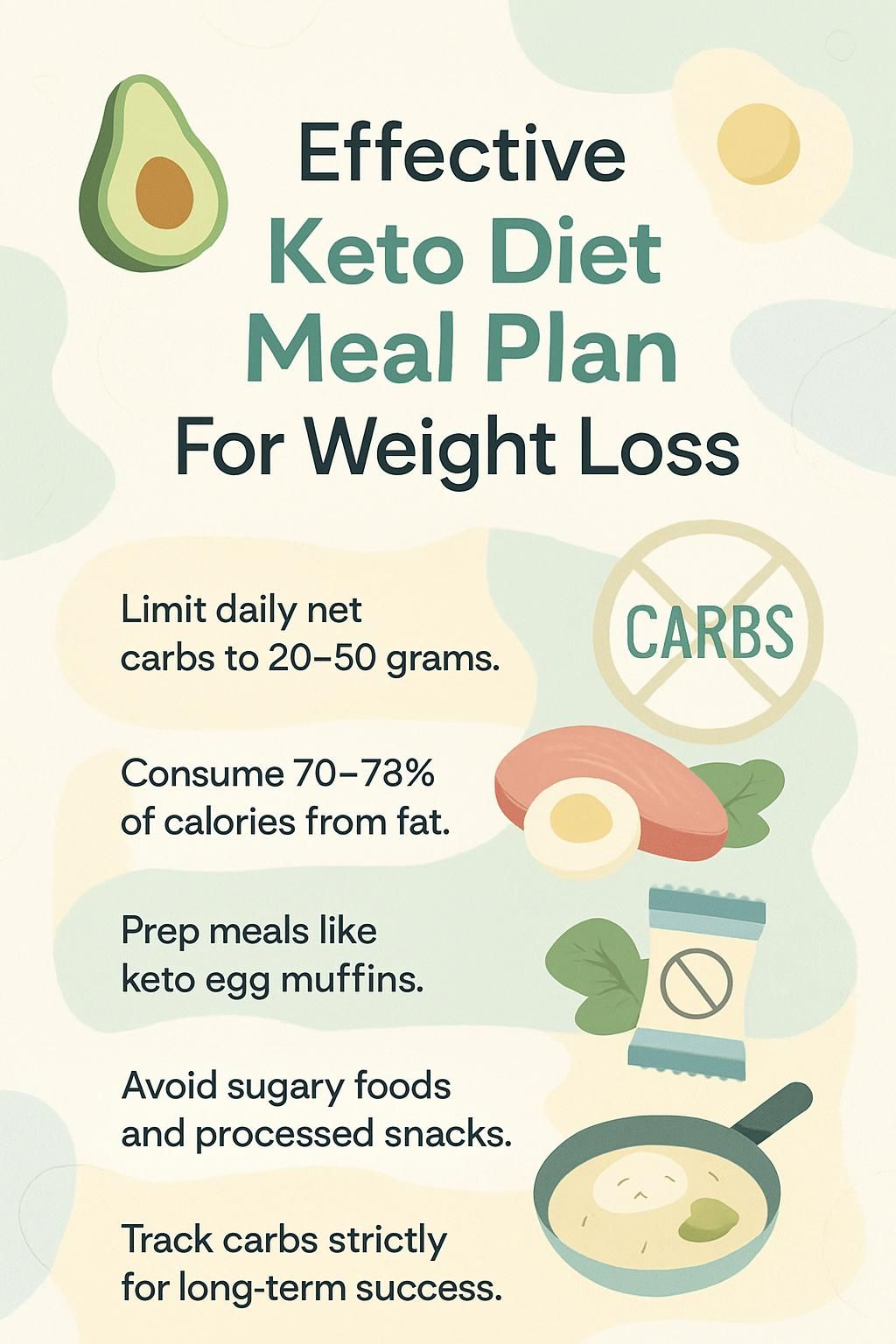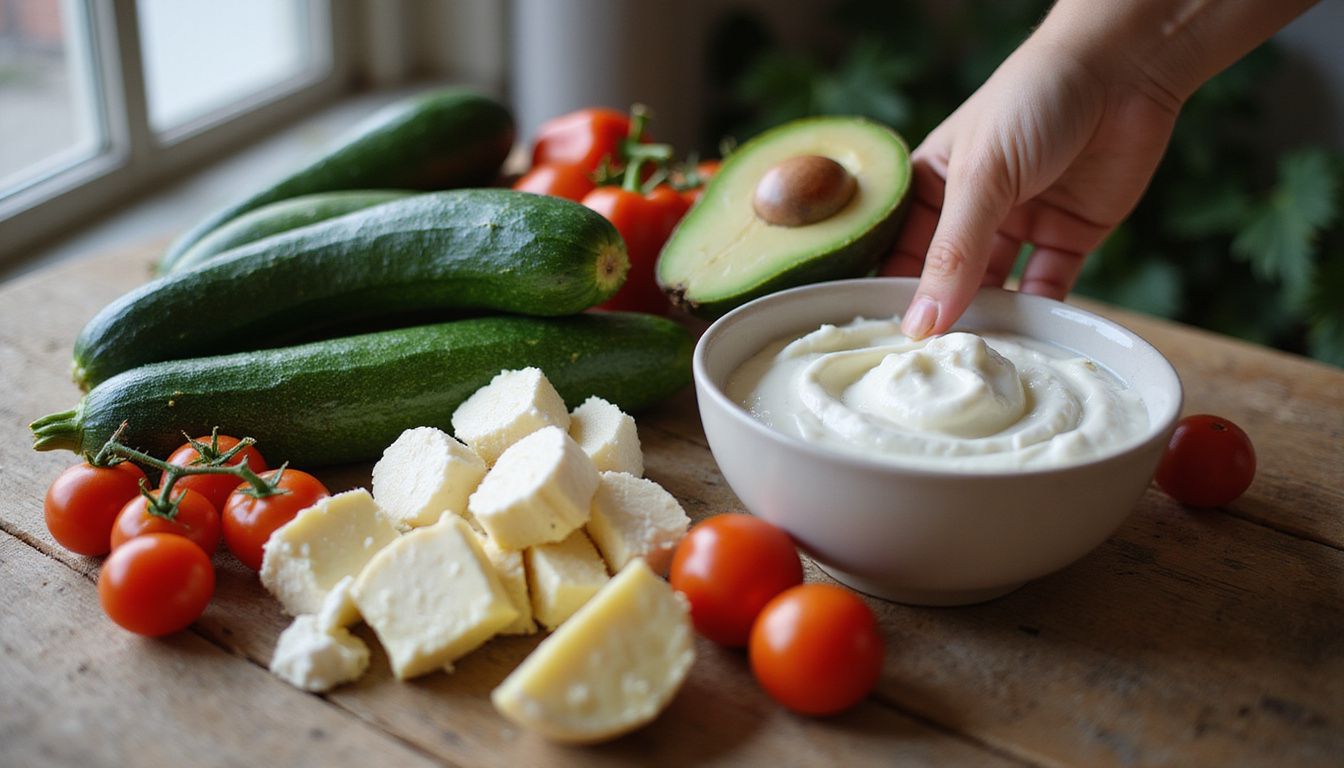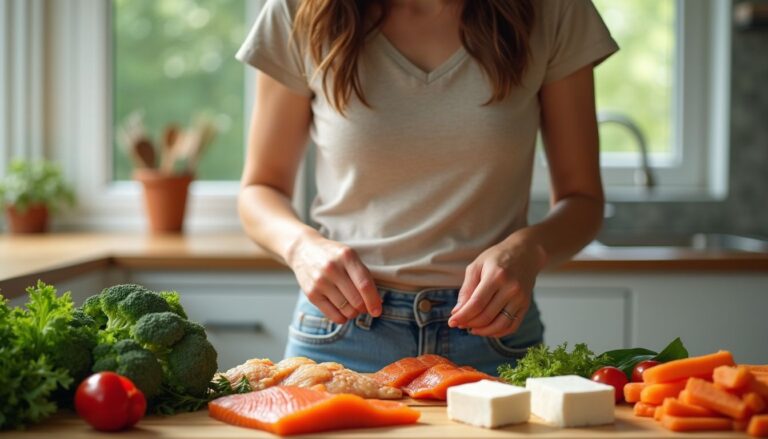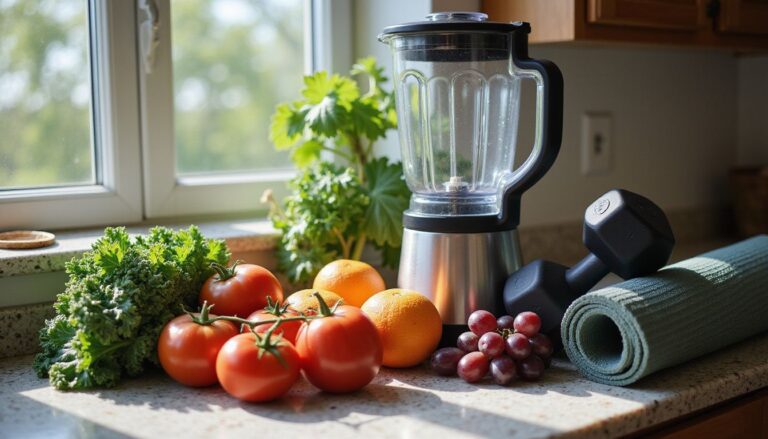Effective Keto Diet Meal Plan For Weight Loss
Our Nutrition Assistant AI Suite will transform your body. You will lose fat, get toned, and build muscle. Gain confidence and optimal health.
If losing weight feels slow and confusing, a simple keto diet plan can help. Research suggests a structured keto diet meal plan may support fat loss and steady hunger control [1].
This guide gives you clear steps to follow a ketogenic diet. You will find shopping lists, meal ideas, and tips to make the plan easier to stick with. Use what works for you and keep it realistic.
[1] Hallberg, S.J., et al. (2018). “Effectiveness and safety of a novel care model for the management of type 2 diabetes at one year: an open label, non-randomized, controlled study.” Diabetes Ther. 9(2): 583-612.
Key Takeaways
- Keto diets limit daily net carbs to 20–50 grams; most calories come from fat. Studies such as Hallberg et al. 2018 report better fat loss and appetite control.
- Findings in Nutrition and Metabolism (2004, 2020) and Obesity Reviews (2014) show greater weight loss than low-fat diets and reduced hunger.
- Sample meal plans use options like egg muffins, chicken burgers, and seafood chowder, often staying under 20 grams net carbs per day.
- Evidence from the Journal of Nutrition (2015) and the British Journal of Nutrition (2016) notes improvements in blood sugar, insulin sensitivity, and some heart risk markers.
- Prep meals, track carbs, and avoid sugary foods, grains, and ultra-processed snacks. People on diabetes or blood pressure medications should get medical guidance.

What Is a Keto Diet?

A ketogenic diet is a high-fat, low-carbohydrate eating plan. It shifts your body from burning glucose, which comes from carbs, to burning fat for fuel. This fat-burning state is called ketosis.
What are the basics of the ketogenic diet?
The core idea is simple. Keep total carbs low, usually 20 to 50 grams per day, and start with under 20 grams of net carbs. Net carbs are total carbs minus fiber. This helps trigger fat burning.
Aim for about 70 to 75 percent of calories from healthy fats like avocado, olive oil, coconut oil, and butter. Protein provides 15 to 20 percent of calories. Carbs stay at 5 to 10 percent.
Good choices include leafy greens, fish, eggs, cheese, nuts, seeds, meat, and other low-carb vegetables. These help manage blood sugar and support weight management.
Tracking your macros, the amounts of fat, protein, and carbs, keeps you on target. Choose whole foods and skip products high in trans fat or added sugars. Many people with insulin resistance do best with a strict 20 grams of net carbs to start.
“On keto, fat becomes your main fuel source instead of glucose.”
Next, see how ketosis can lead to steady weight loss.
How does ketosis help with weight loss?
When carbs drop, your body runs low on glucose. The liver then turns fat into ketones, a clean fuel for your brain and muscles. This switch helps break down stored body fat.
Hunger often falls in ketosis. Obesity Reviews (2014) reports stronger satiety on low-carb, high-fat diets. Nutrition and Metabolism (2004) found greater fat loss than on low-fat diets.
Some people stay in ketosis at up to 50 grams of carbs per day, though stricter limits often work faster. Lower insulin levels on a low-carb diet may also support fat loss and better control of calories. Studies note improved insulin sensitivity and possible help for type 2 diabetes.
Benefits of the Keto Diet for Weight Loss
The keto diet can change how your body uses fuel, which can support weight loss. A review of trials suggests ketogenic eating may help in the long term for some adults.
How does the keto diet improve fat burning?
Limiting carbs near 20 grams of net carbs pushes you into ketosis. In ketosis, your body stops relying on glucose and burns stored fat instead.
Your liver makes ketones from fat. These ketones power your brain and muscles. Nutrition and Metabolism (2020) reported that adults with obesity lost more body fat and improved insulin sensitivity on a ketogenic diet.
Low-carb diets often outperform low-fat diets for fat loss. As Dr. Eric Westman notes, shifting to higher fat and fewer carbs changes how your body handles energy. With steady ketone production, you can burn fat around the clock while staying satisfied.
Can the keto diet help suppress appetite?
Yes. Studies in Obesity Reviews (2014) show strong appetite suppression during ketosis. Ketones may reduce hunger hormones, which makes it easier to eat fewer calories.
Adequate protein and fat keep you full longer. Many people find fewer snacks and smaller portions are enough once they settle into a keto meal plan.
How does keto affect energy levels?
Energy can dip in week one while your body adapts. Some people feel the “keto flu,” which may include headaches, fatigue, or brain fog. These symptoms usually fade after several days.
After the switch, energy often becomes steady. Balanced meals with fat and protein help avoid sugar crashes. Proper hydration and electrolytes, like sodium and potassium, also support energy.
On my vegan keto trial, afternoon slumps faded during week two. Planning meals with greens, nuts, and healthy oils kept my energy consistent.
What are the metabolic health benefits of keto?
Ketogenic eating may lower blood sugar and improve insulin sensitivity, as reported in the Journal of Nutrition (2015). That can help people managing type 2 diabetes.
Studies also report lower triglycerides and better cholesterol profiles in some cases. Research in the British Journal of Nutrition (2016) and PLOS ONE (2015) shows reduced cardiovascular risk factors, including blood pressure.
Many see smaller waistlines and steadier energy. In my case, blood pressure dropped about 10 points after three months, and cholesterol improved. Some studies also suggest possible cognitive benefits, though more research is needed.
Types of Keto Diet Plans
Several versions of keto exist. Each one changes fat and protein targets to fit different needs. Choose the approach that matches your activity level and goals.
Standard ketogenic diet (SKD)
On SKD, fat provides about 70 to 75 percent of daily calories. Protein is 15 to 20 percent. Carbs are 5 to 10 percent, often under 20 grams net per day.
SKD is the most studied version. It is simple, steady, and works well for beginners. Many sample menus and apps use this as the base plan.
You get energy from fats like cream and nuts instead of bread or fruit. Plant-based eaters can use fats such as walnut or flax oil and focus on eggs and tofu for protein.
Targeted ketogenic diet (TKD)
TKD adds a small amount of carbs around workouts. This suits people who lift weights, run, or play sports with higher intensity.
Most carbs stay low during the day. Then you add 15 to 30 grams of fast carbs before or after training. This can improve performance while trying to remain in ketosis the rest of the time.
It requires careful tracking. Too many carbs can knock you out of ketosis. Research on TKD is limited, so adjust cautiously and monitor results.
Cyclical ketogenic diet (CKD)
CKD cycles between strict keto days and higher carb days. For example, five days low carb, two days higher carb. The goal is to refill muscle glycogen for heavy training.
These carb days may include foods like fruit, beans, or whole grains. You still want to avoid sugary drinks. CKD needs precise planning and is less common for general weight loss.
Consider professional guidance if you train hard or have medical conditions such as type 1 diabetes or high blood pressure.
High-protein ketogenic diet
This version raises protein to about 30 percent of calories. Fat is near 60 percent and carbs remain 5 to 10 percent. It can help you keep muscle while losing fat.
Higher protein often boosts fullness. I felt better appetite control when I added smoked salmon to breakfast, keeping net carbs low but protein higher.
Ketosis may be slightly lower than SKD, but many still lose weight and preserve lean mass. Meal planning tools often include this option.
Foods to Include in a Keto Diet
A healthy keto plate can be simple. Choose fats, proteins, and low-carb vegetables that help you stay on track.
What healthy fats and oils are keto-friendly?
Use butter, olive oil, coconut oil, and avocado oil for cooking and dressings. These are almost pure fat and very low in carbs.
- Avocados provide fiber and healthy fats for salads and bowls.
- Nuts and seeds, such as almonds, walnuts, chia, and sesame, add crunch and calories.
- Full-fat dairy like cheese, cream, and plain Greek yogurt offers fat and protein.
- Fatty fish, such as salmon, sardines, and mackerel, supply omega-3s for heart health.
Pick minimally processed oils and skip products high in trans fat. This supports better nutrition while you stay in ketosis.
Which protein-rich foods fit a keto diet?
Choose beef, pork, lamb, poultry, and game meats. Fish like salmon and tuna work well too. Eggs are a flexible staple.
Plain Greek yogurt and cheeses add protein and fat. For vegetarians, tofu and tempeh can help meet protein needs. On SKD, protein is usually 15 to 20 percent of calories. On high-protein keto, it can reach 30 percent.
Hard-boiled eggs make an easy, filling snack. They are simple to pack for school or work.
What are the best low-carb vegetables for keto?
Spinach, asparagus, cucumbers, zucchini, broccoli, and cauliflower are top choices. They are low in net carbs and versatile.
- One cup of raw spinach has about 1 gram net carbs.
- One cup of chopped broccoli has about 4 grams net carbs.
- Cauliflower rice or mash keeps carbs low while replacing grains.
- Zucchini noodles can stand in for pasta in many dishes.
Tomatoes and bell peppers are slightly higher in carbs, so use small portions. Fresh herbs such as basil, dill, and parsley add flavor without extra carbs.
What snacks are suitable for keto?
Keep snacks simple and high in fat or protein. This helps you avoid cravings and keeps daily carbs low.
- Hard-boiled eggs, cheese sticks, olives, or salami.
- Macadamia nuts, almonds, or sunflower seeds, unsweetened.
- Guacamole with celery or cucumber slices.
- Parmesan crisps or baked kale chips for crunch.
- Small servings of berries with a little cream.
Smoothies can work if you keep carbs low. Try spinach, avocado, and a sugar substitute with water or unsweetened milk.
Foods to Avoid on a Keto Diet
Certain foods can raise blood sugar quickly and stop ketosis. Cutting these makes it easier to reach your goals.
Why avoid sugary foods and drinks on keto?
Cakes, cookies, doughnuts, and candy pack fast carbs. These spike blood sugar and often kick you out of ketosis. Sugary drinks like soda and fruit juice link to weight gain and type 2 diabetes.
Even a small glass of juice can exceed your daily carb limit. Unsweetened water, coffee, and tea are better choices. For dessert, try a small, low-carb treat made with a sugar substitute.
Which grains and starches should be avoided?
Bread, pasta, rice, cereal, and crackers are high in carbs. Starchy vegetables like potatoes, sweet potatoes, and corn also push you over your carb budget. Legumes such as beans and lentils are too high in starch for most keto plans.
Swap in zucchini noodles, cauliflower rice, or lettuce wraps. Many people find hitting 20 grams of net carbs gets easier once they remove grains and starches.
What high-carb fruits are not keto-friendly?
Bananas, apples, grapes, mangoes, and pineapples have lots of sugar. A single banana has about 27 grams of carbs. Dried fruits and juices are even more concentrated.
Choose berries instead. Keep portions small, such as half a cup, to stay within your daily carbs.
Why avoid processed and trans-fat foods on keto?
Highly processed foods often hide sugars and starches. They can stall progress and reduce nutrient quality. Trans fats, common in some packaged snacks and fast food, are linked to heart disease risk.
Processed meats can include fillers or added sugars. Focus on whole foods like fresh vegetables, quality proteins, nuts, and healthy oils. Planning around simple ingredients helps prevent accidental carb creep.
A 7-Day Keto Diet Meal Plan
Use this sample plan to hit your targets with less guesswork, one day at a time.
What are keto meal ideas for Day 1?
Breakfast: keto egg muffins with eggs, cheese, and veggies, about 2 grams net carbs.
Lunch: BLTA lettuce wraps using bacon, lettuce, tomato, avocado, and mustard, about 4 grams net carbs.
Dinner: Italian keto meatballs with a simple salad, about 5 grams net carbs.
Daily total: about 11 grams net carbs. Prep extras for tomorrow.
What are keto meal ideas for Day 2?
Breakfast: keto egg muffins, about 2 grams net carbs.
Lunch: Italian meatballs, about 5 grams net carbs.
Dinner: keto chicken burger with jalapeño aioli on lettuce, daily total near 11 grams net carbs.
Batch-cooking the meatballs saves time for later meals.
What are keto meal ideas for Day 3?
Breakfast: egg muffins again, flexible with low-carb veggies, about 2 grams net carbs.
Lunch: keto chicken burger on lettuce, about 4 grams net carbs. Add avocado for more fat.
Dinner: crispy tuna burgers, about 8 grams net carbs.
Daily total: about 14 grams net carbs. Use extra patties as tomorrow’s snack or lunch base.
What are keto meal ideas for Day 4?
Breakfast: veggie keto scramble, about 4 grams net carbs.
Lunch: crispy tuna burgers, about 8 grams net carbs. Mustard adds flavor without carbs.
Dinner: Tex-Mex stuffed zucchini boats, about 5 grams net carbs.
Daily total: about 17 grams net carbs. Keep ingredients on a shared shopping list for easy prep.
What are keto meal ideas for Day 5?
Breakfast: veggie scramble, about 4 grams net carbs.
Lunch: Tex-Mex zucchini boats with seasoned ground beef and cheese, about 5 grams net carbs.
Dinner: Asian chicken stir-fry with low-carb vegetables, about 5 grams net carbs.
Daily total: about 14 grams net carbs. Family-friendly flavors make sticking to the plan easier.
What are keto meal ideas for Day 6?
Breakfast: cheese-crusted omelet, about 5 grams net carbs.
Lunch: quick Asian stir-fry with beef or chicken and broccoli, about 5 grams net carbs.
Dinner: keto seafood chowder with shrimp and fish, about 6 grams net carbs.
Use overlapping ingredients to save money and reduce waste.
What are keto meal ideas for Day 7?
Breakfast: bacon and eggs, about 2 grams net carbs.
Lunch: seafood chowder, about 6 grams net carbs.
Dinner: garlic steak bite salad with olive oil dressing, about 6 grams net carbs.
Daily total: about 14 grams net carbs. Prep ahead where possible to keep choices simple.
Tips for Success on a Keto Diet
Small habits make a big difference. The more you plan, the easier keto becomes.
How can meal prepping help on keto?
Cook extra portions and store them for busy days. This saves time and lowers stress. Prepping deli meats, cheeses, and low-carb vegetables gives you fast options when life gets hectic.
Use a shopping list and plan simple meals. This keeps portions steady and helps you stay within your targets.
Why is staying hydrated important on keto?
During week one, your body loses water as glycogen stores drop. That can cause headaches and fatigue, often called “keto flu.” Drinking water and adding salt, for example a cup of bouillon, can help symptoms.
Good choices include still or sparkling water, unsweetened coffee, and tea. Keep a bottle nearby to make sipping all day easier.
How to manage electrolyte intake on keto?
Increase salt early on. Low-carb diets cause the body to excrete more sodium and potassium. Add salt to meals and use broths to help with sodium.
Eat foods rich in potassium and magnesium, such as leafy greens, avocado, and nuts. If leg cramps or fatigue continue, consider an electrolyte supplement and discuss options with a clinician.
How do you track macros on a keto diet?
Monitor daily fat, protein, and carbs. A common target is 70 to 75 percent of calories from fat, 15 to 20 percent from protein, and 5 to 10 percent from carbs. Keep net carbs under 20 grams per day to start.
Use an app to log meals. Calculate net carbs by subtracting fiber from total carbs. Tracking helps you spot hidden sugars and stay consistent.
Potential Drawbacks and How to Overcome Them
Most challenges are short-term and manageable. A plan and a few tools can get you through them.
What is the keto flu and how to handle it?
The keto flu can occur in the first week. Symptoms include fatigue, headaches, and irritability as your body shifts to fat as fuel. Drink water, increase electrolytes, and rest if needed.
Cut carbs gradually before you start to reduce symptoms. People with health conditions should talk with their doctor first. Most symptoms fade within a few days.
Is the keto diet sustainable long-term?
Long-term success can be hard because of social events and strict limits. Many people miss favorite foods. Some stop after a few months.
There may be risks for some people, such as higher LDL cholesterol. Those with kidney disease or type 1 diabetes require medical guidance. A varied, nutrient-dense plan improves safety and helps with adherence.
How to deal with social and dining challenges on keto?
Preview menus and pick grilled meats, salads, and non-starchy vegetables. Ask for dressings and sauces on the side to control carbs.
Bring a keto-friendly dish to gatherings. If you choose a small treat at a party, move on and get back to your plan at the next meal.
Frequently Asked Questions About Keto Diets
These quick answers cover the questions people ask most before starting.
What is the ideal macronutrient ratio for keto?
Aim for 70 to 75 percent of calories from fat, 20 to 25 percent from protein, and 5 to 10 percent from carbs. On a 2,000-calorie plan, that usually means 20 to 50 grams of carbs per day.
Build meals around meats, eggs, full-fat dairy, fatty fish, and non-starchy vegetables. Keep grains and sugary items off the plate.
Can vegetarians follow a keto diet?
Yes, with planning. Use eggs, Greek yogurt, paneer, and cheese for protein. Tofu and tempeh are helpful as well.
Fill your plate with leafy greens, broccoli, zucchini, nuts, seeds, and healthy oils like olive and coconut. Track carbs to avoid hidden sugars in packaged foods.
How long until you see weight loss results on keto?
Many notice changes in the first week, often from water weight. Fat loss usually follows over the next several weeks if you stay consistent and keep carbs low.
Results vary based on activity level, starting weight, and adherence. A simple plan and regular tracking help most people succeed.
Conclusion
A structured keto diet meal plan can help you lose weight with fewer cravings and more control. You get clear rules, simple meals, and steady habits that make sticking to the ketogenic diet easier.
Focus on low-carb vegetables, quality protein, and healthy fats. Prep ahead, stay hydrated, and manage electrolytes. If you take medication for diabetes or blood pressure, talk with your healthcare professional before starting.
With practice and a realistic plan, many people see improved appetite control, better energy, and steady progress on a keto diet.
FAQs
1. What is an effective keto diet meal plan for weight loss?
An effective keto diet meal plan for weight loss limits carbohydrate intake to about 20 to 50 grams per day and increases healthy fats and moderate protein. Research shows that this approach can help the body enter ketosis, a state where it burns fat for energy instead of carbohydrates. A typical plan includes eggs, poultry, fish, leafy greens, nuts, seeds, and oils such as olive or coconut oil.
2. How does the keto diet support weight loss according to scientific evidence?
Studies published in peer-reviewed journals indicate that ketogenic diets can lead to greater short-term weight loss than low-fat diets. For example, one study found participants lost an average of 2 kilograms more over six months compared to those on a standard low-fat plan (Westman et al., 2007). The reduction in carbohydrates helps lower insulin levels and promotes fat burning.
3. Are there risks or side effects with following a keto meal plan for weight loss?
Some people experience fatigue, headache, or digestive changes during the first week of starting the keto diet; these symptoms are often called the “keto flu.” Long-term risks may include nutrient deficiencies if the plan lacks variety. It is important to consult a healthcare provider before starting any restrictive eating pattern.
4. Can you share a personal experience using an effective keto diet meal plan for weight loss?
After switching from high-carb meals like pasta and bread to lean meats and non-starchy vegetables cooked in avocado oil, I noticed steady weight loss within two weeks. Tracking daily carb intake helped me stay on target while still enjoying flavorful foods such as grilled salmon with spinach salad or scrambled eggs with mushrooms.
Summary: A well-structured keto meal plan focuses on reducing carbohydrates while increasing healthy fats and moderate protein sources. Scientific studies back its effectiveness for short-term weight loss but highlight possible side effects and nutritional gaps if not planned carefully. Personal experiences show that tracking food choices can help maintain progress and make the transition easier.







